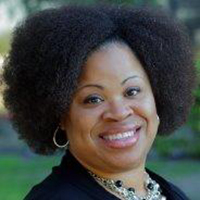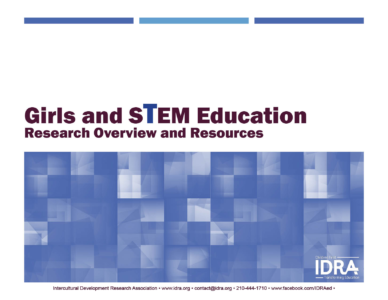• by Paula Johnson, Ph.D., & Michelle Vega • IDRA Newsletter • October 2019 •

 Underrepresentation of young women in STEM education negatively affects their future career paths and results in countless missed opportunities for achievement and discovery in those fields. The implications are even larger for girls of color and for those who are economically disadvantaged. These disparities exist due to wide gaps in science, technology, engineering and mathematics representation and access.
Underrepresentation of young women in STEM education negatively affects their future career paths and results in countless missed opportunities for achievement and discovery in those fields. The implications are even larger for girls of color and for those who are economically disadvantaged. These disparities exist due to wide gaps in science, technology, engineering and mathematics representation and access.
Female students perform equally well as males on standardized tests in math and science, and they tend to earn higher grades than their male peers during high school (Buddin, 2014). But, in education and workplaces, gender equity in STEM is still elusive.
A study conducted by the American Association of University Women (AAUW) concluded that the educational environment around girls shapes their interests and achievements in STEM studies (Hill, et al., 2010). The report points to environmental and social barriers, including stereotypes, gender bias, and the climate of science and engineering courses that continue to hinder women’s progress in STEM.
As society grows its digital economy, it is critical that we position women to be successful within this economy. This includes creating access and opportunity for girls to learn about STEM study and career pathways and encouraging and expecting girls to join the STEM workforce.
Following are some strategies for promoting STEM equity in the classroom. For more suggestions, see IDRA’s eBook: Girls and STEM Education – Research Overview and Resources.
Show the Range of STEM Opportunities
To encourage more girls and girls of color to participate in STEM studies, schools can be more explicit about the range of STEM areas. Schools can also deliberately infuse stories of women’s contributions in the STEM fields and how it benefits girls to pursue advanced coursework in this area. This helps students see themselves in such fields and gives them a chance to find the right fit for themselves.
Encourage STEM Investigations
Teachers can encourage students to conduct STEM investigations based on their own interests and expertise, particularly related to issues in their communities. This can take the form of individual projects or larger project-based learning programs. The key is to demonstrate the application of STEM to real-world questions. For example, a team of youth concerned about the effects of an open sewage treatment plant in their south Texas neighborhood conducted experiments on water quality and presented their findings to the city council (Montemayor, et al., 2017).
See our new eBook: Girls and STEM Education – Research Overview and Resources

Provide STEM Mentoring Opportunities
![]() It is important for girls to connect with successful women in STEM careers. Reaching out to female STEM mentors provides access to professionals who can answer field-related questions. For example, IDRA’s Texas Chief Science Office program that the IDRA EAC-South is managing in Texas connects students with STEM professionals within their community and empowers students to pursue their STEM interests. Students create year-long STEM action plans in their schools and pursue them to completion throughout the school year.
It is important for girls to connect with successful women in STEM careers. Reaching out to female STEM mentors provides access to professionals who can answer field-related questions. For example, IDRA’s Texas Chief Science Office program that the IDRA EAC-South is managing in Texas connects students with STEM professionals within their community and empowers students to pursue their STEM interests. Students create year-long STEM action plans in their schools and pursue them to completion throughout the school year.
Explore STEM Careers and Studies
STEM is a vast landscape of opportunity, and there are many career pathways and college programs to share with students. Elementary school teachers can begin the process by helping students make connections between STEM classes and future career options.
Many programs outside of school interest young students and engage the whole family. Museums, zoos, scouting organizations, and STEM clubs can offer workshops and events for students. Having a strong knowledge base in STEM topics gives students the opportunity to approach higher level coursework in high school with confidence.
Nurture Family Engagement in STEM Learning
Dr. Linda Kekelis (2017), founder of Techbridge Girls, offers the following suggestions for engaging with families for STEM connections.
Bring on the toys. Games like tool sets, blocks, Legos and Tinker Crates give students opportunities to develop skills in science and math. Jenga and Tetris increase critical thinking and engineering principles. Practicing STEM skills in a fun environment allows students to build mastery in these areas in a stress-free setting.
Monitor media messages. Schools can support families in monitoring negative messages girls learn through the media that portray STEM – and particularly computer “nerds” – in ways that are both inaccurate and demeaning. Thankfully, there has been an increase in programming that showcases girls and women in STEM. For example, the movie Hidden Figures features three inspiring Black women from different STEM fields. The film shows how their talents came together to put the first man on the moon. Educators can highlight such media in the classroom and share good examples with families.
Encourage hands-on activity trials. Schools at all grade levels can provide opportunities for families and students to participate in STEM events, like hosting a science fest or math night. Attending these functions demonstrates that families value and support students’ STEM interest and exploration. Teachers can be intentional about inviting girls and their families to STEM events at the school or in the community.
Encouraging young girls to study and pursue careers in STEM is vital to our economy. If girls are entering the workforce in record numbers, it is time to provide them with the tools they need to thrive. The goal is not to merely for them to find jobs. The goal is for students to find a meaningful career – a career that will not only change their lives but open a new trajectory of their family for generations to come.
Resources
Buddin, R. (March 2014). Gender Gaps in High School GPA and ACT Scores. ACT Research and Policy. Information Brief 2014-12.
Goodman, C.L. (2018). “School-Based Strategies for Supporting Girls in Technology – With Perspectives from a 14-Year-Old Coder,” IDRA Newsletter.
Hill, C., Corbett, C., & St. Rose, A. (2010). Why So Few? Women in Science, Technology, Engineering, and Mathematics. Washington, D.C.: American Association of University Women.
Kekelis, L. (October 26, 2017). Parent Engagement: Key for Girls in STEM. The ETR Blog.
Long, H., & Dam, A.V. (September 9, 2019). “For the first time, most new working-age hires in the U.S. are people of color,” Washington Post.
Paula Johnson, Ph.D., directs the IDRA EAC-South. Comments and questions may be directed to her via email at paula.johnson@idra.org. Michelle Vega is IDRA’s Chief Technology Strategist. Comments and questions may be directed to her via email at michele.vega@idra.org.
[©2019, IDRA. This article originally appeared in the October 2019 IDRA Newsletter by the Intercultural Development Research Association. Permission to reproduce this article is granted provided the article is reprinted in its entirety and proper credit is given to IDRA and the author.]



